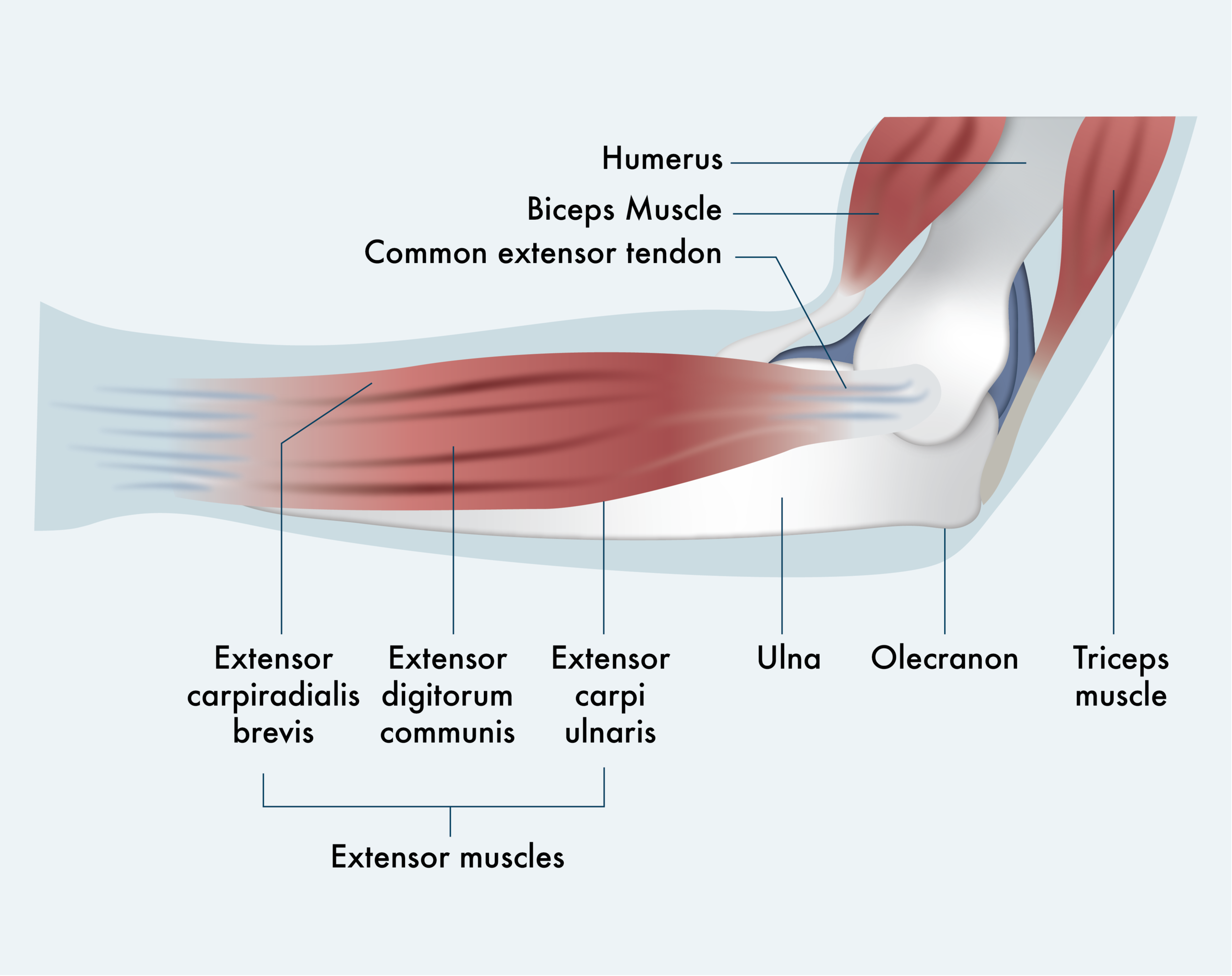
The Elbow
The elbow is an essential hinge joint in the upper extremity. Bending this joint is fundamental to daily activities such as eating, grooming, and exercising. The elbow is at risk for irritation during repetitive stress or injury during a fall.
If you’re experiencing elbow pain, call the office in San Francisco or book an appointment online to get started.
Elbow Anatomy
The elbow consists of three bones called the humerus, radius, and ulna that come together to form a hinge joint. This joint allows for flexion and extension of the forearm as well as a small amount of rotation to aid in daily activities. Attached to the bones of the elbow are flexor and extensor tendons that travel throughout the forearm and aid in the motion of the forearm, wrist, and hand. Tendons in this area are not only important for motion but also provide stability to the elbow.
The Biceps and Triceps muscles are crucial muscles that are responsible for most of the strength of the upper extremity. These muscles have tendons that attach to the elbow. Not only are there bones and muscles in the elbow joint but there are also important nerves that travel through this area, notably the ulnar nerve.
What causes elbow pain?
There are many causes of elbow pain. As the elbow joint is commonly used in most daily activities it is at risk for repetitive stress injuries such as tennis elbow, golfers elbow, biceps tendonitis, or cubital tunnel syndrome. Not only is it at risk for repetitive stress, but due to its location, the elbow is also commonly injured during a fall. A fall on the elbow or wrist can cause an elbow fracture, dislocation, or tear to the biceps or triceps tendon.
Common Conditions
+ Elbow Fracture
Elbow fractures are one of the most common injuries in the upper extremity. A fracture can occur from a fall directly onto the elbow or a fall onto an outstretched wrist that causes increased pressure in the elbow. A fracture can occur to any of the three bones that make up this hinge joint. The most commonly seen fractures are fractures to the radial head, supracondylar fractures of the humerus, and coronoid or olecranon fractures of the ulna.
Symptoms of a fracture include immediate pain, swelling, and decreased range of motion after an injury. Diagnosis is based on a physical exam and, most importantly, x-rays are taken to evaluate the extent of a fracture.
Treatment of elbow fractures varies greatly depending on the severity of the fracture and should be evaluated by a surgeon. Non-surgical treatment can involve immobilization in a splint and sling typically followed by early range of motion exercises with the help of a physical therapist. Surgical treatment will often involve placing a combination of plates and screws at the site of the fracture in order to stabilize the bone and allow for good future outcomes and function.
+ Elbow Dislocation
Elbow dislocations are traumatic events. In the elbow, dislocations are typically caused by a significant fall on an outstretched hand. When the elbow dislocates, the bones can go in various directions. Most commonly, the ulna and radius move posteriorly from their typical locations.
In the event of a dislocation, the most important thing is to relocate the elbow. Relocation will very quickly relieve the substantial pain experienced and improve the ability to move the elbow. An elbow dislocation is diagnosed on X-ray, and its subsequent relocation is confirmed on X-ray as well.
Most commonly, following a dislocation, a sling is used for a short period of time while the elbow begins to heal. Physical therapy is then used to help regain range of motion and strength. A dislocation to the elbow can cause additional injuries such as fractures or tears to the major ligamentous stabilizers in the elbow. In the event of subsequent injuries, surgery may be recommended to maintain stability of the elbow.
+ Tennis and Golfer's Elbow (Medial and Lateral Epicondylitis)
Medial and lateral epicondylitis are the most common cause of elbow pain in adults. These are overuse injuries that cause inflammation to the tendons of the elbow. Medial epicondylitis, also known as golfer’s elbow, is an inflammation of the inside of the elbow where the flexor tendons attach. Lateral epicondylitis, also known as tennis elbow, is an inflammation of the outside of the elbow where the extensor tendons attach. These injuries most commonly occur when people play sports that require repetitive flexion and extension of the wrist such as tennis, golf, bowling, or weight lifting.
Symptoms usually begin with generalized elbow pain that's worse with wrist and forearm motion and gripping. These symptoms typically are noticed during and worsened by repetitive activity but can become noticeable with daily activities as well.
Diagnosis is primarily with physical exam and X-ray. MRIs are not usually ordered in the cases of medial and lateral epicondylitis. Treatment most commonly begins with rest from the aggravating activity, an anti-inflammatory, and physical therapy. This is sufficient to treat the majority of cases, but when symptoms persist a corticosteroid injection may be indicated.
+ Bicep and Tricep Tear
The biceps and triceps muscles have distal tendons that attach to the elbow. Although rare, these tendons can get torn in injuries that cause excessive tension during flexion or extension of your elbow. Symptoms include hearing a pop and experiencing immediate pain in the elbow joint. Afterwards, swelling, weakness, and decreased range of motion may be noted.
Diagnosis requires a physical examination to test strength and an X-ray to see if there was a fracture that occurred with the injury. Afterwards, the most important tool is an MRI to verify the extent of the tear.
All of these injuries should first be evaluated by a surgeon. Depending on age, activity level, and extent of tear, a surgical or non-surgical approach can be taken. Treatment may involve a brief period of immobilization in a sling followed by physical therapy to work on range of motion and strength. Surgical repair of the tendon may be recommended to help regain full strength and return to prior activity level.
+Cubital Tunnel Syndrome
Cubital tunnel syndrome is characterized by compression and inflammation of the ulnar nerve. The ulnar nerve is located on the inside of the elbow and travels through the forearm and hand to provide muscular strength and sensation to the ring and little finger of the hand. Symptoms usually include numbness and tingling of the ring and little finger. These symptoms may be worsened at night while sleeping with the elbow bent or during repetitive activities of the upper extremity. Symptoms usually begin mildly but if not treated properly can cause weakness of the hand or fingers.
Diagnosis of this injury is made with a physical exam, but a nerve conduction study is also useful. With mild symptoms, conservative treatment usually begins with anti-inflammatories, activity modification, and splinting of the elbow in extension at night. In severe cases, a surgery called an ulnar nerve transposition can be performed.
Treatment
At Urgently Ortho we customize a treatment plan to meet your individual needs. For the elbow, some of the most common treatments can include physical therapy, use of anti-inflammatories, the use of a sling or brace, activity modification, or different types of injections. For some conditions surgery is indicated as the best option. See more on our surgery treatments.
Ephraim Dickinson, MD and Breiana Brady, PA-C at Urgently Ortho have extensive experience treating your elbow pain and providing therapies to prevent future problems and to keep you active and healthy. Don’t continue to suffer from elbow pain or immobility. If you have questions about elbow pain, call Urgently Ortho in San Francisco or use the online booking tool to schedule an appointment today.




